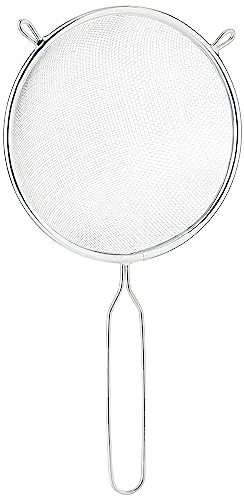Yes, a sieve can be used to separate liquids and solids
When it comes to separating liquids and solids, many people immediately think of using a filter. While filters can be effective in certain situations, sieves can also be a useful tool for this task. Sieves are commonly used in cooking, chemistry, and other industries to separate solids from liquids based on particle size. In this article, we will explore the science behind using a sieve to separate liquids and solids and discuss situations in which a sieve may be the preferred method.
Sieves work based on particle size
Sieves operate on the principle of particle size. A sieve is a device with a mesh or perforated surface that allows smaller particles to pass through while retaining larger particles. When a mixture of liquid and solid is poured onto a sieve, the liquid will pass through the sieve’s openings, leaving behind the solid particles that are too large to pass through. The size of the sieve’s openings determines what size particles will be separated from the liquid. If the liquid and solid mixture has a wide range of particle sizes, multiple sieves with different openings may be required to achieve the desired separation.
Using a sieve versus other methods
While sieves are effective at separating solids from liquids based on particle size, there are other methods available for this purpose. One common method is filtration, where a porous material is used to separate solids from liquids. Filters can be made from materials such as paper, cloth, or even ceramic. Filtration is often used in situations where fine particles need to be removed from liquids, as the filter material can have smaller openings than a sieve. However, filtration can be slower and may require additional equipment such as a vacuum pump to aid in the separation process.
Another method for separating solids from liquids is centrifugation. Centrifugation involves spinning a mixture at high speeds, which forces heavier particles to settle at the bottom of a container while the liquid remains above. This method is particularly useful when separating solids that have different densities, such as in the case of extracting DNA or proteins from biological samples. Centrifugation can be a quicker method of separation compared to filtration or using a sieve, but it requires specialized equipment and may not be suitable for all applications.
In some cases, a combination of methods may be used to achieve the desired separation. For example, a solid-liquid mixture may first be filtered to remove larger particles, and then the remaining liquid may be passed through a sieve to further separate any smaller particles. The choice of method will depend on factors such as the particle size distribution, the required purity of the separated components, and the available equipment.
Applications of sieving in different industries
Sieving is a widely used technique in various industries for separating solids from liquids. In the food industry, sieves are commonly used in the production of flour, sugar, and other powdered ingredients. These sieves help remove any large particles or foreign objects that may be present in the final product. In the pharmaceutical industry, sieves are used to separate fine powders and granules during the manufacturing process of tablets and capsules.
In the chemical industry, sieves are used to separate liquids from solids in different stages of chemical reactions and processes. For example, in the production of chemicals, sieves can be used to remove impurities or separate desired components from a mixture. Sieving is also commonly used in environmental testing labs to separate sediments and contaminants from water samples.
In conclusion, a sieve can be used to separate liquids and solids based on particle size. Sieves operate by allowing smaller particles to pass through their openings while retaining larger particles. While there are alternative methods such as filtration and centrifugation, sieving is often a practical and straightforward solution for many applications. Sieving has various applications in industries such as food, pharmaceuticals, and chemicals, where it is used to separate solids from liquids during production processes. Understanding the science behind sieving and the different techniques available can help determine the most appropriate method for a specific separation task.






